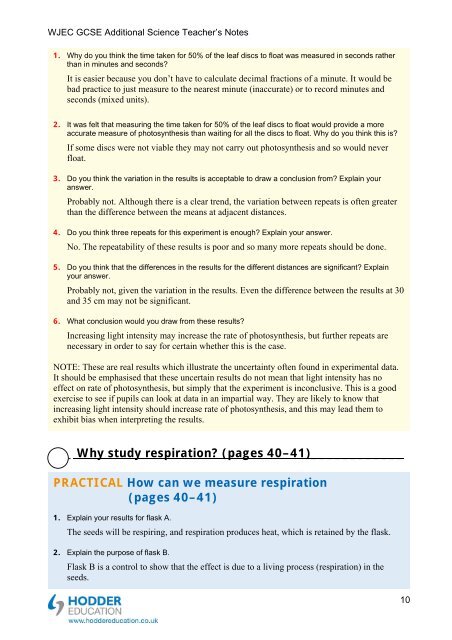Teacher's notes and answers to questions in the book - Hodder Plus ...
Teacher's notes and answers to questions in the book - Hodder Plus ...
Teacher's notes and answers to questions in the book - Hodder Plus ...
Create successful ePaper yourself
Turn your PDF publications into a flip-book with our unique Google optimized e-Paper software.
WJEC GCSE Additional Science Teacher’s Notes<br />
1. Why do you th<strong>in</strong>k <strong>the</strong> time taken for 50% of <strong>the</strong> leaf discs <strong>to</strong> float was measured <strong>in</strong> seconds ra<strong>the</strong>r<br />
than <strong>in</strong> m<strong>in</strong>utes <strong>and</strong> seconds<br />
It is easier because you don’t have <strong>to</strong> calculate decimal fractions of a m<strong>in</strong>ute. It would be<br />
bad practice <strong>to</strong> just measure <strong>to</strong> <strong>the</strong> nearest m<strong>in</strong>ute (<strong>in</strong>accurate) or <strong>to</strong> record m<strong>in</strong>utes <strong>and</strong><br />
seconds (mixed units).<br />
2. It was felt that measur<strong>in</strong>g <strong>the</strong> time taken for 50% of <strong>the</strong> leaf discs <strong>to</strong> float would provide a more<br />
accurate measure of pho<strong>to</strong>syn<strong>the</strong>sis than wait<strong>in</strong>g for all <strong>the</strong> discs <strong>to</strong> float. Why do you th<strong>in</strong>k this is<br />
If some discs were not viable <strong>the</strong>y may not carry out pho<strong>to</strong>syn<strong>the</strong>sis <strong>and</strong> so would never<br />
float.<br />
3. Do you th<strong>in</strong>k <strong>the</strong> variation <strong>in</strong> <strong>the</strong> results is acceptable <strong>to</strong> draw a conclusion from Expla<strong>in</strong> your<br />
answer.<br />
Probably not. Although <strong>the</strong>re is a clear trend, <strong>the</strong> variation between repeats is often greater<br />
than <strong>the</strong> difference between <strong>the</strong> means at adjacent distances.<br />
4. Do you th<strong>in</strong>k three repeats for this experiment is enough Expla<strong>in</strong> your answer.<br />
No. The repeatability of <strong>the</strong>se results is poor <strong>and</strong> so many more repeats should be done.<br />
5. Do you th<strong>in</strong>k that <strong>the</strong> differences <strong>in</strong> <strong>the</strong> results for <strong>the</strong> different distances are significant Expla<strong>in</strong><br />
your answer.<br />
Probably not, given <strong>the</strong> variation <strong>in</strong> <strong>the</strong> results. Even <strong>the</strong> difference between <strong>the</strong> results at 30<br />
<strong>and</strong> 35 cm may not be significant.<br />
6. What conclusion would you draw from <strong>the</strong>se results<br />
Increas<strong>in</strong>g light <strong>in</strong>tensity may <strong>in</strong>crease <strong>the</strong> rate of pho<strong>to</strong>syn<strong>the</strong>sis, but fur<strong>the</strong>r repeats are<br />
necessary <strong>in</strong> order <strong>to</strong> say for certa<strong>in</strong> whe<strong>the</strong>r this is <strong>the</strong> case.<br />
NOTE: These are real results which illustrate <strong>the</strong> uncerta<strong>in</strong>ty often found <strong>in</strong> experimental data.<br />
It should be emphasised that <strong>the</strong>se uncerta<strong>in</strong> results do not mean that light <strong>in</strong>tensity has no<br />
effect on rate of pho<strong>to</strong>syn<strong>the</strong>sis, but simply that <strong>the</strong> experiment is <strong>in</strong>conclusive. This is a good<br />
exercise <strong>to</strong> see if pupils can look at data <strong>in</strong> an impartial way. They are likely <strong>to</strong> know that<br />
<strong>in</strong>creas<strong>in</strong>g light <strong>in</strong>tensity should <strong>in</strong>crease rate of pho<strong>to</strong>syn<strong>the</strong>sis, <strong>and</strong> this may lead <strong>the</strong>m <strong>to</strong><br />
exhibit bias when <strong>in</strong>terpret<strong>in</strong>g <strong>the</strong> results.<br />
_ Why study respiration (pages 40–41)____________<br />
PRACTICAL How can we measure respiration<br />
(pages 40–41)<br />
1. Expla<strong>in</strong> your results for flask A.<br />
The seeds will be respir<strong>in</strong>g, <strong>and</strong> respiration produces heat, which is reta<strong>in</strong>ed by <strong>the</strong> flask.<br />
2. Expla<strong>in</strong> <strong>the</strong> purpose of flask B.<br />
Flask B is a control <strong>to</strong> show that <strong>the</strong> effect is due <strong>to</strong> a liv<strong>in</strong>g process (respiration) <strong>in</strong> <strong>the</strong><br />
seeds.<br />
10

















